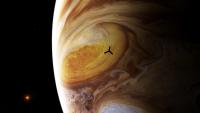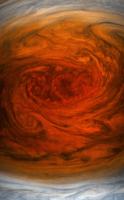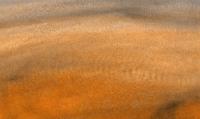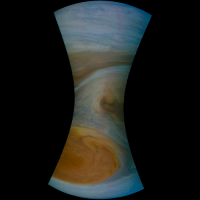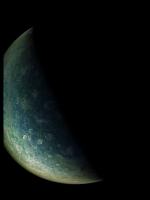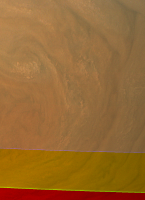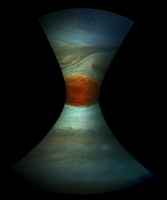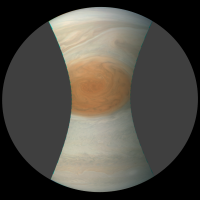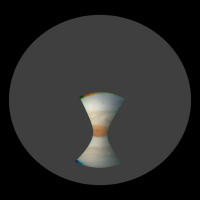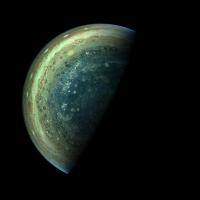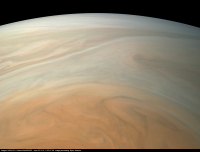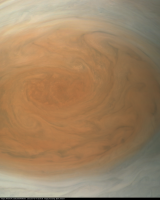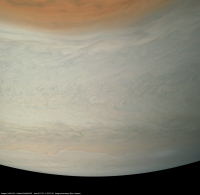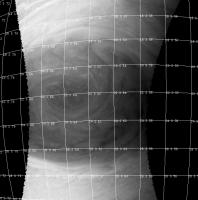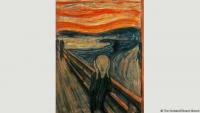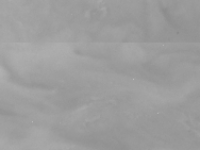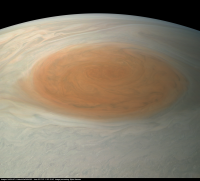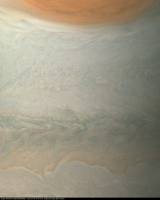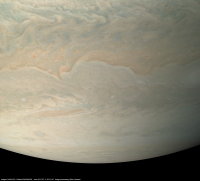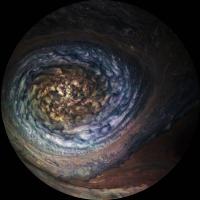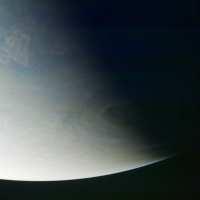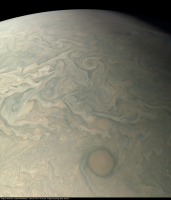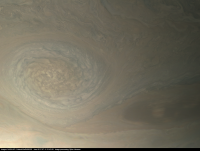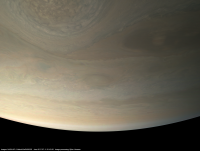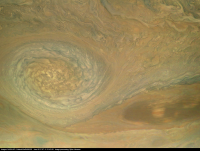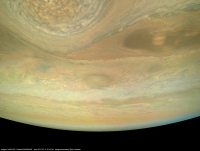Printable Version of Topic
Click here to view this topic in its original format
Unmanned Spaceflight.com _ Juno _ Juno perijove 7: GRS images
Posted by: Gerald Jun 30 2017, 12:38 PM
There are another three days left over to https://www.missionjuno.swri.edu/junocam/voting?current.
This time, all eyes will be on the Great Red Spot (GRS). Provided everything works as scheduled, one RGB image will be made almost above the center of the GRS. I'd think, that this RGB image will be complemented by a methane image. Since this time, we won't have contact with Earth during the flyby, the amount of data to be collected is rather constraint. Therefore, only a small number of images of the polar region is scheduled, just enough for a long-term observation. Storage will be sufficient for imaging several POIs to be voted for, but we may not get a full latitudinal coverage.
In order to obtain a full latitudinal coverage of the GRS and adjacent regions, we should take at least one image near the northern and one image near the southern edge of the GRS, better a set of five RGB images. We would see the GRS from different angles, and we would be able to study the turbulence north and south of the GRS. I'd also expect, that only images from north and south of the GRS will be able to cover most of its longitudinal extent.
In addition, a sequence of images near the GRS would provide the raw material for a great and unprecedented fly-over movie.
That said, there are several other interesting or potentially interesting targets to consider. Besides for an adjacent region of the GRS, I voted for the two polar-most POIs, since I hope, that we'll get some additional polar and subpolar images for a long-term study, and more close-ups of those incredibly turbulent FFR zones near the poles.
Posted by: PhilipTerryGraham Jul 1 2017, 01:55 PM
Presenting, https://www.reddit.com/r/junomission/comments/6kn2qa/rjunomissions_logo_for_perijove_7/ ![]()
Posted by: Candy Hansen Jul 6 2017, 06:58 PM
We have scheduled 3 GRS images - one that will capture the northern edge, one centered as Juno is right over the GRS, and one looking from the south. The third one will include the methane filter.
As you might imagine the project and the media are very interested in seeing these image products as soon as possible! We can't really predict exactly when they will be downlinked, but I will jump on here to let you know when they have hit the earth and are in the pipeline. This is the message I got from Scott Bolton, the PI: "I am hoping Candy can reach out to a few amateur colleagues to get them prepped to work fast. The reward will be the first to post a quality image will get the credit from NASA and I've suggested that NASA reach out for a quote from the person processing the image to inquire how it felt to the first human to see the GRS up close.".
So I know you all will process the images just because that is your passion, but there will also be intense interest from the project to release your beautiful products and, if you are interested, to interview you.
FYI, I love showing off the products you post on the missionjuno website! ![]()
Posted by: nprev Jul 7 2017, 01:14 AM
All right, all you image wizards...here's a personal invite from a real live space mission to astonish a worldwide audience!!! Looking forward to seeing the results!
Thank you for this, Candy; we at UMSF are honored! ![]()
Posted by: Candy Hansen Jul 7 2017, 04:39 PM
I am such a newbie I started a new topic, when I intended to put this under the PJ7 thread. I've asked one of the moderators if it can be moved. Sorry!
Posted by: Roman Tkachenko Jul 7 2017, 10:50 PM
Can't wait for new images!
While we wait for new image I just put here this picture. 
Posted by: t_oner Jul 9 2017, 02:38 PM
Would we have a GRS floyover with the original orbit? If so when?
Posted by: Sean Jul 10 2017, 02:57 PM
Using Bjorn's Voyager mosaic for this comp...
https://flic.kr/p/WAV9VZ
Posted by: Candy Hansen Jul 10 2017, 05:37 PM
I've been asked this a lot...
When will the GRS images be downlinked? These are the factors:
* We have no downlink during the perijove pass because the spacecraft is in the MWR attitude. This means that all data must be stored on-board. The JunoCam onboard storage is 1181 Mb.
* Once downlink starts we play back engineering first, then FGM, then the other instruments
* The instrument round-robin will start at 6:40 am on Tuesday; JunoCam gets roughly 6 min per hour
* We start by playing back the images collected at -24 hr. Those images are compressed, so it is difficult to calculate the speed of playback precisely. Also, if other instruments’ buffers empty early then playback of JunoCam data will speed up.
* If the GRS images happen to be played back in the middle of the night there is no one at MSSS to see that they’ve arrived - that will happen at open of business
* Once we get the actual images we still need the c kernel with the spacecraft attitude to run the processing pipeline. Usually the C kernel arrives within a day of perijove, so this shouldn’t be a delay.
* As soon as the raw images are posted we will let everyone know that they are available at missionjuno.
Very conservatively I've estimated July 14, expecting that it is likely we'll see them at least a day before.
Hope this is helpful!!
Posted by: mcaplinger Jul 10 2017, 06:55 PM
Pacific Daylight Time (UT-7h) I presume. You can look at https://eyes.nasa.gov/dsn/dsn.html to see when Juno is being tracked; we have to be on a 70m antenna to get a decent downlink rate.
Posted by: Roman Tkachenko Jul 10 2017, 07:15 PM
Thanks a lot for the information!
Posted by: Explorer1 Jul 11 2017, 03:36 AM
DSN shows Juno talking to Earth (only a carrier wave for now).
Posted by: mcaplinger Jul 11 2017, 04:22 AM
It's a mission goal to do this at least once. Since neither the long-term position of the GRS or the exact orbit parameters can be predicted exactly, there's no way to know when in the original mission plan it would have happened.
Posted by: PhilipTerryGraham Jul 11 2017, 04:37 AM
I guess all that's important now that it happened
Posted by: Gerald Jul 11 2017, 05:05 AM
The predicted SPICE kernels look as if a change of s/c attitude has been anticipated for 08:13 UTC, i.e. in a few hours. That's my best guess, when downlink will start.
I also presume, that c-kernel data of today will miss the GRS flyby by about two hours, such that my best guess for the availability of the first raws will be tomorrow (2017-07-12) morning PDT.
Posted by: PhilipTerryGraham Jul 11 2017, 02:49 PM
I have been checking DSN Now as early as ~10:00 UTC, and the spacecraft's been downlinking data at a consistent rate of 152.76 kb/s ever since. First using Goldstone, but now the torch has been passed on to Madrid for now.
Posted by: mcaplinger Jul 11 2017, 06:51 PM
For those following along, we switched to the 34m net about 10 AM PDT, and this only supports about 30 Kbps. That'll be near-continuous, but I don't think we get more 70m time until mid-day PDT tomorrow.
Posted by: mcaplinger Jul 12 2017, 02:23 PM
Expect a partial set of images from PJ7 to show up on missionjuno in an hour or so (posted 07:23 PDT on 12 July.)
UPDATE: images posted as of 07:49 PDT.
Posted by: Bjorn Jonsson Jul 12 2017, 03:08 PM
Woo-hoo! Now the fun starts...
Thanks for the update.
Posted by: Gerald Jul 12 2017, 04:06 PM
PJ07, #060:
This one ensures, that we have at least something.
In this short time, I didn't determine Juno's angular velocity, but adjusted the rotational phase to fit to the model.
The PNG version is submitted to the missionjuno site.
Now working on the other close-ups, at least for a first version...
Posted by: PhilipTerryGraham Jul 12 2017, 04:24 PM
I have to say, the views of the Great Red Spot remind me so much of Pioneer's Jupiter - a pastel-like red spot contrasted against a seemingly clear, while field. https://www.missionjuno.swri.edu/junocam/processing?id=1584 It's kinda poetic; Juno is front seat to a Great Red Spot reminiscent of the one its distant spin-stabalised cousins saw 44 years ago.
Posted by: Sean Jul 12 2017, 04:55 PM
Wow Gerald that was fast!
Here is my initial pass...
https://flic.kr/p/Vraos6
Posted by: Candy Hansen Jul 12 2017, 05:01 PM
This is gorgeous - please post this on missionjuno!!
Posted by: Explorer1 Jul 12 2017, 05:09 PM
Jaw-dropping! I know it's huge, but getting the scale right without some marker is still difficult (and this is after a few decades of shrinkages!)
I wonder what Arthur C. Clarke would say....
Posted by: Sean Jul 12 2017, 05:10 PM
Thanks Candy...just posted it.
Posted by: PhilipTerryGraham Jul 12 2017, 06:15 PM
By the way, Sean and Gerald, just thought I'd humour you guys by saying https://www.reddit.com/r/junomission/comments/6mull7/the_great_red_spot_raw_images_are_now_available/dk4osv6/?context=6. ![]()
Posted by: Sean Jul 12 2017, 06:34 PM
Gotta love naysayers!
Here is a detail from Gerald's image...
https://flic.kr/p/WtcUCa
Posted by: rogelio Jul 12 2017, 06:50 PM
Look at the parallel "ripple clouds" near the top of the Spot in Gerald's image. There's a field of about 35-40 of them spaced around 75 km apart (if my calcs are correct)
Posted by: tolis Jul 12 2017, 07:19 PM
A view through Jupiter's navel?
Posted by: Ant103 Jul 12 2017, 08:14 PM
My take based on the WONDERFUL work of Gerald ![]()
http://www.db-prods.net/blog/wp-content/uploads/2017/07/JNCE_2017192_07C00060_V01-raw.bmp_reproj_30px_30.280000s_cx813.0_000000_enh.jpg
There are amazing details on the clouds inside the GRS, like some convective storms. Also, we can clearly see that the GRS is not like any earth analog. This is as storm, a hurricane, but there are other systems inside. It's like a storm made of storms.
Posted by: avisolo Jul 12 2017, 09:28 PM
GIF of latest flyover of Jupiter's Great Red Spot by NASA's Juno spacecraft:
http://i.imgur.com/JpjaO2f.gifv
Posted by: jccwrt Jul 12 2017, 09:39 PM
Here's my take on Gerald's processed version. Tried not to push the contrast enhancement too far. Everything is white-balanced to the brightest clouds.
https://flic.kr/p/WBmWVL
Posted by: antipode Jul 12 2017, 10:26 PM
WOW! I see another area of enhanced convection/overshoot just outside the core in a vortex at the 1 o'clock position. This is gunna get good.
Could someone tell me if these high white cloudtops represent H20 or ammonia convection?
P
Posted by: Gerald Jul 13 2017, 12:11 AM
PJ7, #60 (reviewed), and #61
PNG versions, except reviewd #60 submitted to missionjuno.
The images are rendered with an assumed rotation period of 30.7007 s for Juno, and 80.96 frames per rotation. Calibration of the parameters by eye, not yet formally.
Thanks for all your derived versions! Those are really astonishing. I see, that there is always something I can learn.
Posted by: Bjorn Jonsson Jul 13 2017, 01:51 AM
Wow. The GRS also has the high altitude clusters of small clouds that are so common elsewhere in the Juno images. I also suspect Juno may have succeeded in directly imaging altitude differences between bigger clouds. I get the impression that the dark areas in the GRS are lower than the brighter ones but this needs to be analyzed much more carefully.
Here is a quick and dirty crop from a 250 pixels/degree simple cylindrical map that my software is now producing; in this case it takes several hours to run. This is image PJ7_060. The image shows what I mentioned above. I'm including the bottom part here just for fun. It shows that the processing isn't complete yet. The color in the upper part of the image is preliminary but should be fairly close to true color.
Posted by: Sean Jul 13 2017, 02:01 AM
Thanks for your excellent work Gerald. Here are some processed images based on yours...
PJ07_53
https://flic.kr/p/W63hf9
PJ07_61
https://flic.kr/p/WBKYeb
PJ07_53 detail
https://flic.kr/p/W63hSS
PJ07_61 detail
https://flic.kr/p/W65Zvw
Can't wait to see your efforts Bjorn.
Posted by: jccwrt Jul 13 2017, 03:53 AM
Approaching the Great Red Spot...
https://flic.kr/p/Vs1N2n
And not to be outdone by the GRS, the north polar hood has a large cyclone along its southern edge:
https://flic.kr/p/WqBW6m
Posted by: GS_Brazil Jul 13 2017, 12:08 PM
How do I have to understand these images? I'm always under the impression that the middle of the image is exaggerated, and so the GRS seems to be much much bigger than what we would see on the traditional images. A kind of Fish-eye effect.
The 'original' ( I know this is composed and stitched from the real original R B G images ) image looks a bit more natural to me:
Is it because I'm used to rectangular images and the rounding at the top and bottom of the 'original' image as a matter look like being border of the planet?
In this context map I do see that that's not the case ...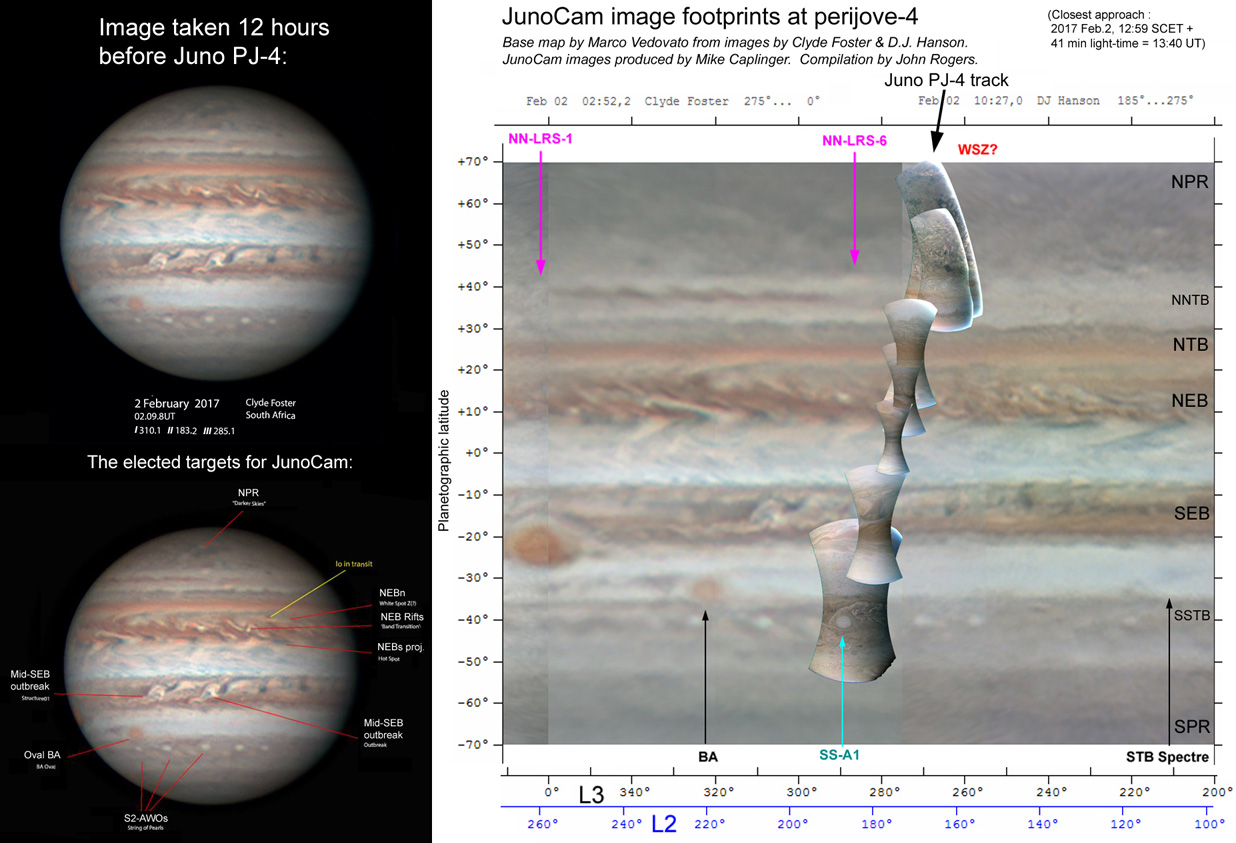
But still, every time I see an image posted I get the impression that there's something wrong with the image scale / distortion / fish-eye effect ...
Anyhow, it's fantastic to see Gerald and Sean's work here. Amazing how much detail can be extracted from these raw images.
Posted by: Gerald Jul 13 2017, 12:41 PM
A cylindrical projection of #60 looks like this:
The panorama images I'm usually creating, are projected to spherical coordinates from the perspective of the camera near the time of the exposure, with latitudes of the frame as horizontal axis, and the equator a vertical axis in the horizontal center. This ensures, that the images are about the same resolution as the raws, or some almost constant factor of the raw resolution.
Any significant deviation from this projection distorts, enlarges, or reduces the size of the pixels in the raws, resulting in a considerable loss of information, or in excessive supersampling, both in the same image.
The horizontal fov of the above spherical projections is 60 degrees. Ther vertical fov is up to 180 degrees. JunoCam looks from horizon to horizon, from only a small altitude compared to Jupiter's diameter.
Posted by: Bjorn Jonsson Jul 13 2017, 01:56 PM
The 'original' ( I know this is composed and stitched from the real original R B G images ) image looks a bit more natural to me:
Is it because I'm used to rectangular images and the rounding at the top and bottom of the 'original' image as a matter look like being border of the planet?
In this context map I do see that that's not the case ...
This is a PJ-4 context map plus images from John Rogers' excellent summary of the PJ-4 JunoCam observations: https://britastro.org/node/9274
And yes, many of the processed GRS images exhibit a Fish-eye like effect due to the very large field of view. Here is for example a quick and dirty perspective render of image PJ7_60 from Juno's position when the PJ7_60 framelets were obtained. It has a field of view of 124 degrees (!), this very large FOV is needed to show all of Jupiter from limb to limb. For this not to look distorted you need to be *very* close to the screen when looking at the image.
EDIT: And here is also a perspective render showing what this could like like as seen from the Earth. Here the field of view is very small:
Posted by: GS_Brazil Jul 13 2017, 01:56 PM
Gerald, thanks for the explanation. This image you are showing here looks natural to my eye, I don't see any distortion.
However, other images look very strange to me, like this one:
https://flic.kr/p/Vs1N2nhttps://flic.kr/p/Vs1N2n by https://www.flickr.com/photos/132160802@N06/, no Flickr
Posted by: Bjorn Jonsson Jul 13 2017, 02:07 PM
Note: I took the two perijove 7 threads ("Juno perijove 7" and "GRS images") and merged them into a single thread and renamed the resulting thread.
Posted by: Gerald Jul 13 2017, 03:19 PM
GS_Brasil: "...other images look very strange to me...":
That's image #59, taken a mere 6276 km above Jupiter's 1 bar "surface". Here, Jupiter's surface curvature is contributing considerably to the perspective.
I'll try to prepare a fly-over for the GRS until early next week. This should make things more intuitive.
Posted by: jccwrt Jul 13 2017, 03:22 PM
Departing the Great Red Spot. Still lots of "popcorn" convection in the South Tropical Zone, although I don't think that's a surprise at this point.
https://flic.kr/p/WrjHdL
Posted by: PFK Jul 13 2017, 05:59 PM
I take it BBC's report includes some of the brilliant efforts off here?
http://www.bbc.co.uk/news/science-environment-40594126
Posted by: Explorer1 Jul 13 2017, 07:55 PM
Just saw an article illustrated with that same image in the BBC report in today's edition of my local paper, the Victoria Times Colonist. You were credited Jason!
It's pretty satisfying to see ordinary people finally get credited rather than just acronyms like NASA, ESA, were on previous missions.
Posted by: jccwrt Jul 13 2017, 10:01 PM
Wallpaper version of the 4 GRS images from the Perijove 7 campaign:
https://flic.kr/p/VtoByt
Posted by: Tom Tamlyn Jul 13 2017, 10:54 PM
The BBC report additionally contains two images credited to Sean, one of the forum's principal image magicians, and one credited to Kevin Gill, an active space image processor and also a forum member, although apparently not an active poster.
Posted by: mcaplinger Jul 13 2017, 11:16 PM
Beautiful job. I think we might use this in our press release if it's OK with you. One minor quibble: these images were taken at 02:03, 02:07, 02:10, and 02:12 UT (Spacecraft Event Time) on 11 July 2017. I think there might be some time zone confusion going on.
Posted by: jccwrt Jul 13 2017, 11:32 PM
Yeah, I'm fine with that. I meant to put the time of perijove on the image, but it looks like I found the wrong time. At any rate, I've uploaded a version to the Juno website without the text if that helps.
EDIT: Changed the image to the correct perijove time.
Posted by: Bjorn Jonsson Jul 14 2017, 01:15 AM
A bit late to the party but here are my versions of the PJ7_60 image. As I usually do I decided to break this up into three separate images to get something similar to what one would obtain with a regular camera at Jupiter. To show Jupiter from limb to limb requires a *very* wide field of view, much wider than a typical camera has.
These are approximately true color/contrast views. The only enhancement is that I sharpened small scale features a bit, mainly to compensate for the resampling that occurred during some of the processing steps. These images have the same resolution in km/pixel as the original framelets.
And the associated metadata for image PJ7_60:
IMAGE_TIME = 2017-07-11T02:07:07.724
MISSION_PHASE_NAME = PERIJOVE 7
PRODUCT_ID = JNCE_2017192_07C00060_V01
SPACECRAFT_ALTITUDE = 9866.1 km
SPACECRAFT_NAME = JUNO
SUB_SPACECRAFT_LATITUDE = -24.4222
SUB_SPACECRAFT_LONGITUDE = 58.2555
TITLE = POI's: The Great Red Spot, Edge of Great Red Spot, Within the Wake of the Great Red Dot
Resolution at nadir: ~6.6 km/pixel
Murphy's law struck during the processing. Windows decided that it would be a good idea to reboot my machine about 30 minutes after I went to sleep last night. At that time my machine was running 6 instances of the software I use to process and reproject the raw framelets. This delayed everything by at least 5-10 hours. I thought I had managed to completely prevent these unwanted reboots but no - they still happen but now only on rare occasions (in particular occasions when I absolutely don't want them...).
Posted by: Sean Jul 14 2017, 02:42 AM
PJ07_62 from Gerald's batch...
https://flic.kr/p/VtxDjK
PJ07_62_detail
https://flic.kr/p/Wvpryz
Posted by: Sean Jul 14 2017, 09:56 AM
PJ07_60 Detail v2
https://flic.kr/p/VqXdDo
Some agressive processing to try to eke more variation.
Posted by: Bjorn Jonsson Jul 14 2017, 12:29 PM
Here is an aproximately true color/contrast animation showing how Juno's rotation sweeps JunoCam's field of view across Jupiter's disc from north to south:
https://vimeo.com/225551533
The animation is from Juno's position when it was obtaining the PJ7_60 framelets. It is based on SPICE data for Juno's position and JunoCam's pointing. For clarity it has been slowed down by a factor of 2 relative to Juno's spin rate. The horizontal field of view (FOV) is 57 degrees. The time it takes to see Jupiter from limb to limb shows very well how large Jupiter appears to Juno at this close range (a FOV of more than 120 degrees would be needed to show Jupiter from limb to limb).
Posted by: Sean Jul 14 2017, 01:26 PM
I posted this image...
based on a scale comparison in this video...
https://youtu.be/FTfS8p0eO-A?t=4m14s
I have responses ranging from 'Spot On' to 'Wrong'...both from academics.
I'm concerned that I have unintentionally muddied the water on this and hope someone here will provide some accurate scales with which to fix the post...or not.
*updated link to replace fix*
Posted by: mcaplinger Jul 14 2017, 01:55 PM
I'm afraid I'm solidly in the "wrong" camp on this -- based on some rough sanity checks based on the size of the Spot you have the Earth 2-3 times too small. Junocam images are tricky, as the scale varies a lot over the image due to foreshortening. I wouldn't trust most people to be able to definitively figure this out; I can't do it myself without doing a little work, which I'll do later today.
Posted by: Sean Jul 14 2017, 02:11 PM
Thanks. I have updated the post & hope this is closer to the reality for now... apologies for the error.
https://flic.kr/p/W8vCxN
I will update again once the sums are done.
Posted by: GS_Brazil Jul 14 2017, 02:14 PM
https://flic.kr/p/Wvpryz
I'm under the impression that I've seen this brownish / reddish cigar storm feature before in PJ06.
Are you guys somehow tracking how certain features evolve over time?
Posted by: jccwrt Jul 14 2017, 02:34 PM
This is a different example of a relatively common atmospheric feature called a "barge". The barge from PJ06 was located near the northern boundary of the South Temperate Belt, which is the light/dark boundary at the top of Sean's picture. This one is at the southern boundary of the South Temperate Belt.
Posted by: mcaplinger Jul 14 2017, 04:17 PM
In PJ7-0060 the east-west limb-to-limb view centered on the GRS covers about 10 degrees of longitude and the north-south extent of the GRS is about 10 degrees of latitude. See attached grid image (I apologize for this ugly figure, I don't have any good tools to make publication-quality grids.)
The scale on Jupiter is pi*2*70000/360 = 1222 km/degree roughly (using 70000 for the radius and ignoring oblateness). Longitudes have to be multiplied by cos(lat) but that's not a big effect at the latitude of the GRS (cos(22) is 0.93).
So in this image, the GRS is about 12000 km in vertical extent. That's just about the diameter of the Earth, so your revised image looks about right.
Note that the GRS has been shrinking over time, so there are all kinds of estimates for how big it is on the Web, and I wouldn't trust most of them. See http://www.lpi.usra.edu/opag/july2014/presentations/Day_1/9-Simon_OPAG.pdf but that's from 2014.
Posted by: Sean Jul 14 2017, 04:59 PM
Awesome! Thanks for the reply.
Posted by: mcaplinger Jul 14 2017, 05:12 PM
Maybe I'm having some web cache problem, but the image still looks wrong upstream in post #59 (for a while the link was dead, it's now come back with the original incorrect version.)
Posted by: Sean Jul 14 2017, 05:39 PM
I wanted to preserve the error to keep discussion relevant. My update edit was worded poorly.
Here is GRS eating Earth...
https://flic.kr/p/W8VEiU
Using correct scale & PJ07_062
Posted by: Gerald Jul 14 2017, 06:21 PM
This one has the potential to go viral.
I thought, that the effect and ambiguity of perspective should be removed somehow. Even before I found time to suggest something like this, you found a super-intuitive solution!
I hope, there won't be too many people who will believe, that this scenario might be real.
Posted by: PFK Jul 14 2017, 06:44 PM
Amazing stuff on here (as usual!). The contrast between the undulating reds of the spot and the blue and white flows below it....it's almost enough to make you scream ![]()
Posted by: Sean Jul 14 2017, 07:17 PM
That's why I used a tabloid style satirical headline. I hope it is understood as a fun infographic.
Posted by: jccwrt Jul 14 2017, 09:14 PM
Image #56, taken near the southern edge of the North Equatorial Belt. There's a very clear cyclonic feature here, which appear to be closely associated with some ripples on its western side. I wonder if the ripples are due to a velocity change in the atmospheric flow as it passes around the cyclone.
https://flic.kr/p/WEWTJu
Posted by: Ant103 Jul 15 2017, 11:14 AM
What I could do with your imagery Gerald ![]()
http://www.db-prods.net/blog/wp-content/uploads/2017/07/JNCE_2017192_07C00061_V01_brightened_GTR_equirect.jpg
But I particulary like what I've done with this one, taken during the closest point to Jupiter I think (#57 ?) :
http://www.db-prods.net/blog/wp-content/uploads/2017/07/JNCE_2017192_07C00057.jpg
(I did a blog article about it : http://www.db-prods.net/blog/2017/07/15/survols-de-jupiter-par-juno/ )
Posted by: Sean Jul 15 2017, 02:33 PM
The lens effect is a great idea Damia...so effective. It's is one of my favourites!
Here is another crack at Gerald's PJ07_053_v2...
https://flic.kr/p/Vtt56j
Detail from v3
https://flic.kr/p/Wasd65
Posted by: Gerald Jul 15 2017, 07:37 PM
Damia, your artistic skills are one order of magnitude beyond mine, at least! Really fascinating.
---
In the meanwhile, I've rendered a 43.2 seconds GRS fly-over animation. It is 25-fold time-lapsed, covering 18 real-time minutes with 25 fps, i.e. one still per second, format is 1920x1080, i.e. full HD. I guess, that I'll spend most of the week-end to get it online, somehow.
At some point tonight, I'll prepare a website with the zipped stills, which will be updated incrementally, as new portions will be uploaded. Still sequences will overlap in order to allow blending in a reasonably wide range of times.
Posted by: Sean Jul 15 2017, 08:03 PM
That is great news Gerald...can't wait to get my mitts on it. Do you have a rough estimate when all frames will be uploaded?
In the meantime I had another go at PJ07_62_detail [upscaled]
https://flic.kr/p/WGAoEL
There is so much going on in there...quite hypnotic.
Posted by: Gerald Jul 16 2017, 12:31 AM
My https://www.youtube.com/watch?v=1zPsYP8h9EE is online now.
http://junocam.pictures/gerald/uploads/20170716/movies_pj07/, currently with dangling hyperlinks, except the AVI.
The stills are about 6 GB of zip files. My upload bandwidth is usually about 100 kb. Considering several system shutdowns during the upload, including some intentional breaks, I'd expect, that the upload will be completed near 2017-07-17T00:00:00, i.e. in about one day from the time of submitting this post.
Posted by: Gerald Jul 16 2017, 06:36 AM
The zip files 61_1, 61_2, 62_0, and 62_1, i.e. the last four are uploaded, thus far without technical issues. If everything continues the same way, the remaining zips should be available today, 2017-07-16, at about 16:00 UTC.
Posted by: Sean Jul 16 2017, 09:51 AM
Thanks Gerald, downloading fine.
Posted by: Sean Jul 16 2017, 03:43 PM
Here is a re-timed video using your files Gerald.
https://flic.kr/p/WwEdZw
Music is Lux Aeterna by György Ligeti
I did a little processing and disguised the linear path change. My time was limited so the transition around 15s could be better!
Posted by: Gerald Jul 16 2017, 04:23 PM
http://junocam.pictures/gerald/uploads/20170716/movies_pj07/.
I've also added an MP4 version, sampled with 50 fps, by frame doubling, I guess, simply used the ffmpeg default.
"Lux Aeterna" has been one of Glenn Orton's suggestions. My vote goes to another of his suggestions, "Also sprach Zarathustra", the most famous "2001" sound for the most famous Jupiter feature, applied to a 10-fold time-lapse, hence a 2.5-fold slow-down of my version.
Posted by: brellis Jul 16 2017, 05:37 PM
That's gorgeous! You get a feel for the immense scale of this planet. I love the Ligeti for its raw energy, and probably also for its association with some other classic film about space. ![]()
Posted by: PhilipTerryGraham Jul 16 2017, 05:47 PM
So, https://www.reddit.com/r/junomission/comments/6ncimb/the_great_red_spot_in_highquality_approximate/dkamiam/?context=3 wanted to know what http://i.imgur.com/JU9y9PY.jpg in Bjorn's image could be. I don't have an answer for him, so I'm asking you guys on his behalf. Just an artifact of processing or something like that?
Posted by: mcaplinger Jul 16 2017, 06:11 PM
Looks like it's an uncorrected artifact from the crud on the image sensor.
There are some charged particle hits in these images but this doesn't look like one to me.
It's always a good idea to go back to the raw data in cases like this. Things that show up in only one color are usually one of these two things.
Posted by: Gerald Jul 16 2017, 08:56 PM
In http://www.unmannedspaceflight.com/index.php?showtopic=8313&view=findpost&p=236510, there is the same bright pixel, and I try to patch even very subtle camera artifacts, based on PJ06. So, it's either a new hot pixel, a rare coincidence of artifacts that I don't patch, or an "event".
The by far most likely option for an "event" is an energetic particle hit. There is a remote chance for a lightning, but since it appears to be just one pixel, I doubt it.
Posted by: Bjorn Jonsson Jul 16 2017, 10:24 PM
At least some of the PJ7 images are a bit noisy. That's the reason for a few strange pixels in my images; I haven't succeeded in fixing all of them. This is negligible compared to Galileo and Voyager but my impression is that the PJ7 images are probably more noisy than the PJ6 images. Here is an example from the raw data, enlarged by a factor of 3:
I suspect these are radiation hits because the number and position of these artifacts differs from image to image.
Posted by: Bjorn Jonsson Jul 17 2017, 05:02 PM
Here are approximately true color versions of PJ7_61:
And some of the relevant metadata:
IMAGE_TIME = 2017-07-11T02:10:42.286
MISSION_PHASE_NAME = PERIJOVE 7
PRODUCT_ID = JNCE_2017192_07C00061_V01
SPACECRAFT_ALTITUDE = 13917.4 km
SPACECRAFT_NAME = JUNO
SUB_SPACECRAFT_LATITUDE = -32.6733
SUB_SPACECRAFT_LONGITUDE = 60.7938
TITLE = POI's: Lower Great Red Spot Atmospheric Flow, Fractured Boundary
Resolution at nadir: ~9.4 km/pixel
Posted by: stevesliva Jul 17 2017, 05:50 PM
Wow, beautiful. The redness of the GRS makes it look more like your usual enhanced color composites.
Posted by: Decepticon Jul 17 2017, 09:51 PM
Its amazing how Jupiter Red Spot looks more like the Pioneer 10/11 Images.
Posted by: Sean Jul 18 2017, 05:49 PM
A fun take on GRS/Earth scale.
Click thru for a video...
https://flic.kr/p/VzGtxN
Posted by: Nate_Bradford Jul 19 2017, 07:32 AM
Hi All -
Newbie here. I've visited site many times, in the past. Fantastic processing work by many of you.
A Q please.
I've created a rough Anaglyph using GRS pass images but haven't seen any posted elsewhere. Do any of you know whether a correctly processed image (corrected for camera, motion etc distortions) in 3D is forthcoming from the Juno team?
Thanks ![]()
Posted by: Gerald Jul 19 2017, 01:02 PM
https://britastro.org/node/10696 contains an animated GIF derived from the four close-up PJ07 GRS images. The images of the GIF are reprojected from the raws to the same position on the spacecraft trajectory, and manually corrected for most of the residual geometrical inaccuracies.
It shows a global acyclonic rotation of the GRS. Extracting residual parallax for 3D images in an unambiguous way is pretty hard, and I'm unaware of any successful attempt. Using these images as L/R images of an anaglyph would visualize true motion of features between images as a 3D impression. Being aware of this effect could help to identify subtle differential motion within the GRS.
Posted by: Sean Jul 30 2017, 02:30 PM
Here is my take on the GRS sequence using Gerald's work...
https://flic.kr/p/XfwLj2
Upscaled, processed & cropped.
Posted by: nogal Jul 30 2017, 05:09 PM
Am I seing two moons (images 2 and 3) crossing from left to right?
Posted by: Gerald Jul 30 2017, 10:51 PM
That's most likely energetic particle hits. Most repetitive camera artifacts are filtered out. Lighnings are possible, but unlikely. Moons would probably look differently, less sharp, and probably moving diagonally due to the rapidly changing perspective. They would probably be displaced between camera color filters, showing up as three dots in a row in different colors within one image. Note, that we are rather close to Jupiter during the flyby, just a fraction of the Roche limit. Moons that close to Jupiter would be very unusual, however not entirely impossible.
Posted by: nogal Jul 31 2017, 05:03 PM
Many thanks for your information-packed reply, Gerald.
I went searching for the Roche limit and the Wikipedia article added a lot to what I remembered. If I understood correctly, the limit for a rigid body is about 900km (PJ7 was at 3500km). Anyway WIBN if those were moons ar a broken comet/asteroid taking a final plunge...
Cheers
Fernando
Posted by: Gerald Jul 31 2017, 09:50 PM
The https://en.wikipedia.org/wiki/Roche_limit#Rigid-satellite_calculation is about 1.26 times the radius of the primary body, multiplied by a factor derived from the density quotient. With Jupiter's radius of about 70,000 km, we get a Roche limit of 70,000 km x 0.26 = 18,000 km altitude. This applies to rigid bodies of a density of about 1.3 g/cm³ like https://en.wikipedia.org/wiki/Jupiter's mean density. An iron asteroid could probably plunge into Jupiter's atmosphere without prior break-up due to its high density compared to Jupiter.
The images of the GRS have been taken from altitudes between 6200 km (#59), and 16,500 km (#62).
Small bodies of sufficient https://en.wikipedia.org/wiki/Shear_strength and https://en.wikipedia.org/wiki/Ultimate_tensile_strength may survive well within their formal Roche limit, too.
Impacts of small bodies into Jupiter's atmosphere have been observed. Hence unlikely, but not ruled out to observe such an event.
http://www.skyandtelescope.com/astronomy-news/new-impact-flash-seen-at-jupiter/ have been observed in March 2016, and in May 2017.
Posted by: nogal Jul 31 2017, 10:14 PM
Thanks again Gerald.
The article was the one you point out but I misunderstood the tables... Oh well, back to the homework ![]()
![]()
Posted by: Sean Aug 1 2017, 12:03 AM
I had another stab at Gerald's PJ07_062...
https://flic.kr/p/X6LuxK
Here are some 4k images cropped from the portrait...
https://flic.kr/p/W5hU9z
https://flic.kr/p/XeQ5GN
https://flic.kr/p/W5hStR
https://flic.kr/p/W5hRvD
Upscaled, processed & extended
Posted by: Gerald Aug 2 2017, 10:52 PM
Here the result of some recreation with PJ07, #053:
It shows Jupiters NN-LRS-1, NN for north-north, LRS for "Little Red Spot". This version is reprojected to about one and a half minutes after the original image time, in order to bring the storm closer to nadir. Then, I've enhanced the image with a sequence of several methods, first an automated heuristics which adjusts for some of the illumination and light scattering effects followed by gamma stretch to the 4th power of radiometric values, then some arbitrary white-balancing, non-linear brightness-stretch, some saturation enhancement, sharpening, point-noise filtering, masking to a disc.
Posted by: Johann Guillon Aug 26 2017, 01:39 PM
It shows Jupiters NN-LRS-1, NN for north-north, LRS for "Little Red Spot". This version is reprojected to about one and a half minutes after the original image time, in order to bring the storm closer to nadir. Then, I've enhanced the image with a sequence of several methods, first an automated heuristics which adjusts for some of the illumination and light scattering effects followed by gamma stretch to the 4th power of radiometric values, then some arbitrary white-balancing, non-linear brightness-stretch, some saturation enhancement, sharpening, point-noise filtering, masking to a disc.
Hi Sir, your work on raw images is trully awesome, without you we have nothing.
You did this for perijove 6 : http://junocam.pictures/gerald/uploads/20170607/
Did you make the same for perijove 7 ?
I need this to watch something at the terminator and your images has more range than ones processed by others, so it's easier.
On my twitter profile you can see some other examples : https://twitter.com/JohannGuillon
Thank you for your work, really.
Johann
Posted by: Gerald Aug 26 2017, 07:00 PM
Thus far, I've rendered http://junocam.pictures/gerald/uploads/20170826/. They aren't quite perfect regarding RGB alignment, since I didn't run a specific calibration.
Most interesting regarding the haze structures is probably http://junocam.pictures/gerald/uploads/20170826/JNCE_2017192_07C00051_V01-raw_proc_hollow_sphere_c_pj_out.BMP_thumbnail_.html. Here an enhanced crop:
I'll see, whether I'll be able to render the departure sequence in a similar draft mode. In that case, I'll add another post in a few hours,
Posted by: Johann Guillon Aug 26 2017, 10:51 PM
Most interesting regarding the haze structures is probably http://junocam.pictures/gerald/uploads/20170826/JNCE_2017192_07C00051_V01-raw_proc_hollow_sphere_c_pj_out.BMP_thumbnail_.html. Here an enhanced crop:
I'll see, whether I'll be able to render the departure sequence in a similar draft mode. In that case, I'll add another post in a few hours,
So it's haze ! What a planet !
Thank you Gerald !
Posted by: Gerald Aug 27 2017, 03:38 AM
Yes, I think it's usually called haze, e.g. in http://www-personal.umich.edu/~atreya/Articles/2005_Jupiters_Ammonia.pdf.
http://junocam.pictures/gerald/uploads/20170827/.
Posted by: Johann Guillon Aug 29 2017, 11:52 PM
http://junocam.pictures/gerald/uploads/20170827/.
Again thank you for your work Gerald.
Have a great day
Posted by: Bjorn Jonsson Sep 2 2017, 12:34 PM
Below are five images processed from PJ07_53. There are three approximately true color/contrast images followed by two images where the contrast, colors and sharpness have been enhanced. There is one 'exception' though. In the first image (a true color/contrast image), the brightness near the terminator has been increased a bit to show various dimly lit features more clearly.
A subset of the metadata:
IMAGE_TIME = 2017-07-11T01:42:08.663
MISSION_PHASE_NAME = PERIJOVE 7
PRODUCT_ID = JNCE_2017192_07C00053_V01
SPACECRAFT_ALTITUDE = 11444.6 km
SPACECRAFT_NAME = JUNO
SUB_SPACECRAFT_LATITUDE = 44.5048
SUB_SPACECRAFT_LONGITUDE = 40.2871
TITLE = POI: Juno eye
Resolution at nadir: ~7.7 km/pixel
Posted by: JRehling Sep 3 2017, 03:10 AM
Beautiful work, Bjorn.
Interesting aspect to the dark oval on the lower part of the right side: It seems like we may be seeing brown serpentine stripes overlying a brighter circular feature. If I'm seeing correctly, it looks like the pattern at higher altitude is not related to the shapes below it, which would in turn imply completely different wind patterns at different altitudes, which is something I don't recall seeing often or ever.
Posted by: Brian Swift Nov 5 2017, 09:11 PM
Here is my PJ07 departure movie. Coloration along edges due to imperfections in my camera model.
https://youtu.be/wHbw2_wfZVQ
Posted by: Sean Feb 19 2018, 02:34 AM
PJ07_53 [G.Eichstadt] +details
https://flic.kr/p/237hUcT
https://flic.kr/p/24pyTDJ
https://flic.kr/p/GkPKm9
https://flic.kr/p/GkPHY9
https://flic.kr/p/21JDyds
Posted by: Sean Mar 3 2018, 12:55 PM
New pass on PJ07_61 using Brian's new pipeline...
https://flic.kr/p/24MacFS
Posted by: Sean Mar 4 2018, 02:11 AM
PJ07_60 with Brian's pipeline, aligned RGB & some sharpening
https://flic.kr/p/GJ9ufs
https://flic.kr/p/GJ9vmf
Posted by: Sean Apr 8 2018, 12:39 PM
PJ07_GRS_Reprojected [Eichstadt/Doran]
https://flic.kr/p/HP7SBY
Posted by: Gerald Aug 9 2018, 03:57 PM
https://youtu.be/TQ3LT17ZlVc.
http://junocam.pictures/gerald/uploads/20180807/jnc_pj07_HD_v02.mp4.
http://junocam.pictures/gerald/uploads/20180807/.
I've provided a revision of the immediate fly over the GRS in extra ZIP files on that web page. The result of my first run was flickering and over-exposed. So, I've adjusted my automated exposure adjustment method to be more resilent for the very red scene.
There are a few large gaps in latitude coverage, especially after the GRS fly-over. This perijove pass was designed mostly for GRS observations, less for a full flyby movie. Storage available for JunoCam data was extended for later flybys.
Posted by: avisolo Aug 10 2018, 12:34 AM
Thanks so much Gerald, this is wonderful! Treat yourself to some John Barry:)
https://vimeo.com/284264460
Powered by Invision Power Board (http://www.invisionboard.com)
© Invision Power Services (http://www.invisionpower.com)

